Gobi and plantain 65 is a delicious Indian recipe served as a Side dish....
This oriental noodle salad is an interesting Chinese flavour combined with crunchy fried ...
These Annam Vadiyalu are made in a summer season special side dish recipe made with rice....

These Gourmet Oatmeal Cookies are chock full of goodies, have great flavor....

Mildly spiced coated fish steam cooked in banana leaves. This dish is a very popular deli...

It is made from sugar, gram flour, flour, ghee, milk, and cardamom.Some people are of the...
Cabbage Kofta in Spring Onion Gravy is an easy Indian vegetarian kofta recipe.
The cabbage kofta is simple preparation of cabbage dumplings which are deep fried and served with creamy sauce.
Cabbage is a popular species of the Brassica oleracea linne group and is used as a leafy vegetable. It is an herbaceous, biennial flowering plant which is crowded with mass of leaves, usually green but in some varieties red or purplish. The plant is also called head cabbage or heading cabbage. Cabbage leaves often have a delicate, powdery, waxy coating called bloom. The occasionally sharp or bitter taste of cabbage is due to glucosino... Read More..
|
About Recipe
|
|||||||||||||||||||||||||||||||||||||||||||||||||
|
|||||||||||||||||||||||||||||||||||||||||||||||||
Cabbage is a popular species of the Brassica oleracea linne group and is used as a leafy vegetable. It is an herbaceous, biennial flowering plant which is crowded with mass of leaves, usually green but in some varieties red or purplish. The plant is also called head cabbage or heading cabbage. Cabbage leaves often have a delicate, powdery, waxy coating called bloom. The occasionally sharp or bitter taste of cabbage is due to glucosinolate(s). The English name Cabbage derives from the Normanno-Picard caboche (head), perhaps from boche (swelling, bump). Cabbage was developed by ongoing artificial selection for suppression and the only part of the plant that is normally eaten is the leafy head; more precisely, the spherical cluster of immature leaves, excluding the partially unfolded outer leaves. Cabbage is used in a variety of dishes for its naturally spicy flavor. The so-called "cabbage head" is widely consumed raw, cooked, or preserved in a great variety of dishes. It is the main ingredient in coleslaw. Normally this vegetable is widely used in Chinese cuisine especially added into the soups or stews. Cabbage soup is most popular in Central and Eastern Europe, and cabbage is an ingredient in some kinds of borscht. Cabbage is used in many popular dishes in India for example the cabbage kofta curry, channa cabbage and the cabbage foogath. Boiling tenderizes the leaves and releases sugars, which leads to the characteristic "cabbage" aroma. Boiled cabbage becomes stigmatized because of its strong cooking odor and the belief that it causes flatulence. Moreover, boiling reduces the cabbage's anti-cancer properties. It is also be prepared and served with many other vegetables or boiled meat. Cabbage rolls, a type of dolma, is an East European and Middle Eastern delicacy. The leaves are softened by parboiling or by placing the whole head of cabbage in the freezer, and then stuffed with a mixture of chopped meat and/or rice. A vegetable stuffed with shredded cabbage and then pickled is called mango. It is said that the largest cabbage dish ever made was on 19 December 2008 in the Macedonian city of Prilep, with 80,191 sarmas (cabbage rolls) weighing 544 kg (1,221 lbs). Cabbage is an excellent source of vitamin C. It also contains significant amounts of glutamine, an amino acid that has anti-inflammatory properties. Cabbage can also be included in dieting programs, as it is a low calorie food. There are many varieties of cabbage based on shape and time of maturity. Cabbage has a round shape and is composed of superimposed leaf layers. There are three major types of cabbage: green, red, and Savoy. The color of green cabbage ranges from pale to dark green. Both green and red cabbages have smooth-textured leaves. Red cabbage has leaves that are either crimson or purple with white veins running through it. The leaves of Savoy cabbage are more ruffled and yellowish-green in color. Red and green cabbages have a more defined taste and crunchy texture as compared to Savoy cabbage's more delicate nature. Bok choy as well as Chinese (Napa) cabbage are other varieties of cabbage available. Bok choy has a mild flavor and a higher concentration of vitamin A. Chinese cabbage, with its pale green ruffled leaves, is great to use in salads. Red cabbage contains additional health benefits not found in green cabbage. Sturdy, abundant, and inexpensive, cabbage is a longstanding dietary staple throughout the world and is so widely cultivated and stores so well that it is available throughout the year. However, it is at its best during the late fall and winter months when it is in season. Cabbage has a long history of use both as a food and a medicine. It was developed from wild cabbage, a vegetable that was closer in appearance to collards and kale since it was composed of leaves that did not form a head. It is thought that wild cabbage was brought to Europe around 600 B.C. by groups of Celtic wanderers. It was grown in Ancient Greek and Roman civilizations that held it in high regard as a general panacea capable of treating a host of health conditions. Cabbage is an excellent source of vitamin K and vitamin C. It is also a very good source of fiber, manganese, folate, and vitamin B6 potassium and omega-3 fatty acids. Cabbage is also a good source of thiamin (vitamin B1), riboflavin (vitamin B2), calcium, magnesium, vitamin A, and protein. The health benefits of cabbage include treatment of constipation, stomach ulcers, headache, excess weight, skin disorders, eczema, jaundice, scurvy, rheumatism, arthritis, gout, eye disorders, heart diseases, ageing, and Alzheimer's disease. Throughout history, the Asian cuisine has been rich and abundant in cabbage and its various varieties. Cabbage is relatively cheap yet one of the richest when it comes to protective vitamins. One cup of cabbage contains only around 15 calories. Cabbage is rich in the following nutrients like the Vitamin A, Vitamin C, Vitamin E, Vitamin B Nutritive Values of Cabbage : Per 100 gm. Vitamin A : 80 I.U. Vitamin C : 50 mg. Calcium : 46 mg. Phosphorus : 31 mg. Potassium : 140 mg. Carbohydrates : 5.3 gm. Protein : 1.4 gm. Calories : 24
 Easy recipes
Easy recipes
 Healthy Recipes
Healthy Recipes
 Dessert Recipes
Dessert Recipes
 Mutton and Lamb
Mutton and Lamb  Indian Bread Recipes
Indian Bread Recipes
 Dal Recipes
Dal Recipes
 Chutney and Pickles
Chutney and Pickles  Indo-Chinese Recipes
Indo-Chinese Recipes
 Snacks and Appetizers
Snacks and Appetizers
 Low Fat Recipes
Low Fat Recipes
 Chaat Recipes
Chaat Recipes
 Biryani and Rice
Biryani and Rice  Curry Recipes
Curry Recipes
 Indian Sweet Recipes
Indian Sweet Recipes
 Egg Recipes
Egg Recipes
 Paneer Recipes
Paneer Recipes
 Chicken Recipes
Chicken Recipes
 Indian tiffins
Indian tiffins
 Egg less Recipes
Egg less Recipes
 Soups and Salads
Soups and Salads
 Indian Sea Food
Indian Sea Food
 Manchurian Recipes
Manchurian Recipes
 Indian Drinks Recipes
Indian Drinks Recipes
 Dinner Recipes
Dinner Recipes